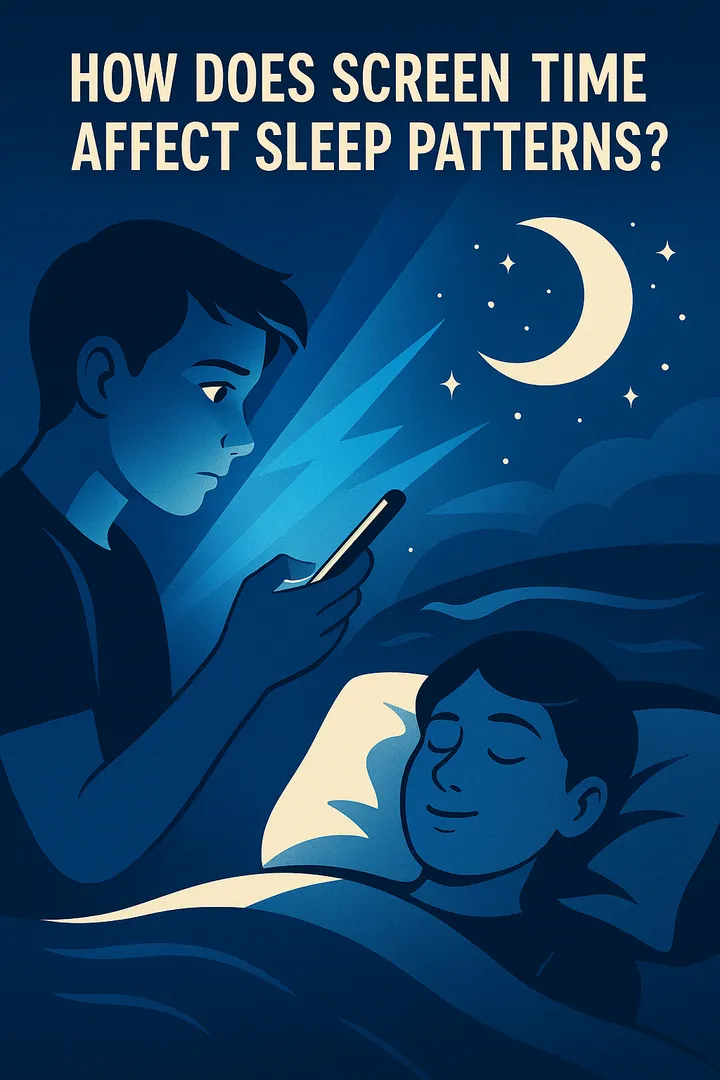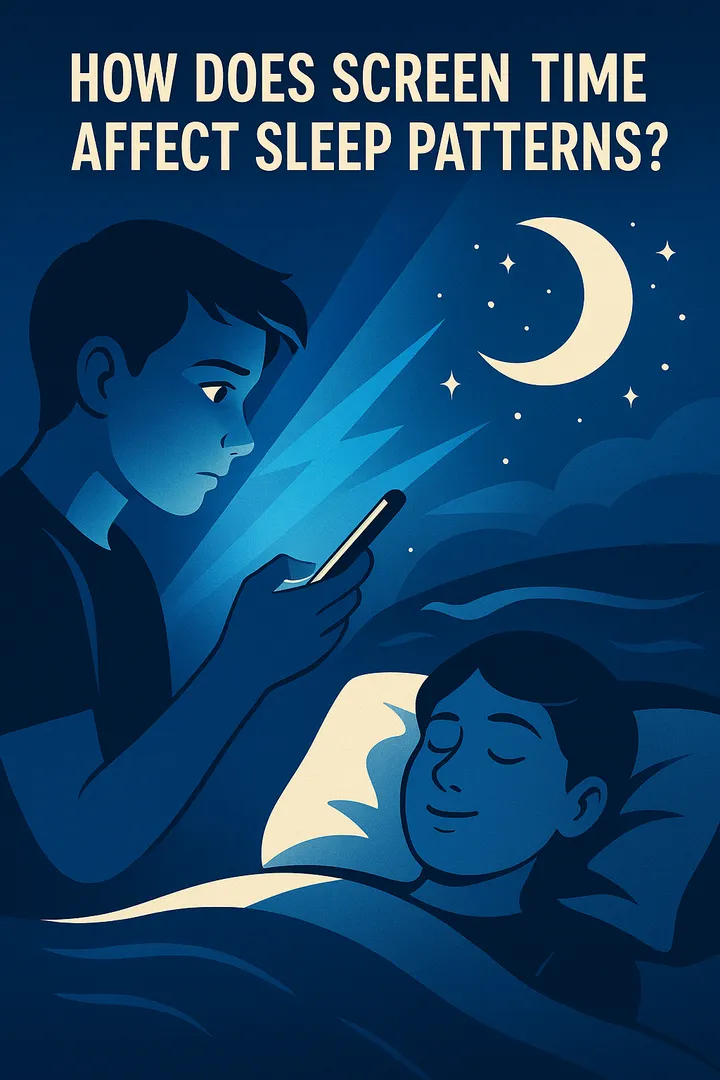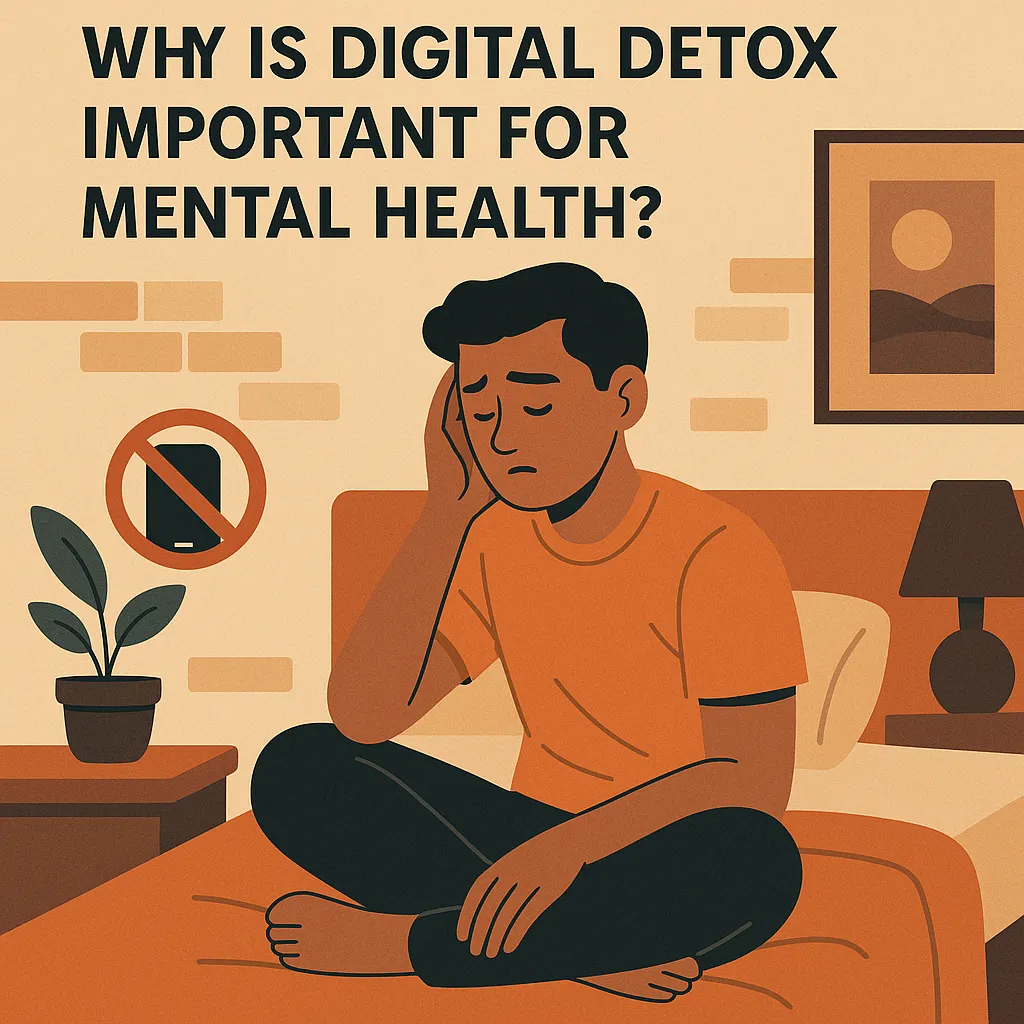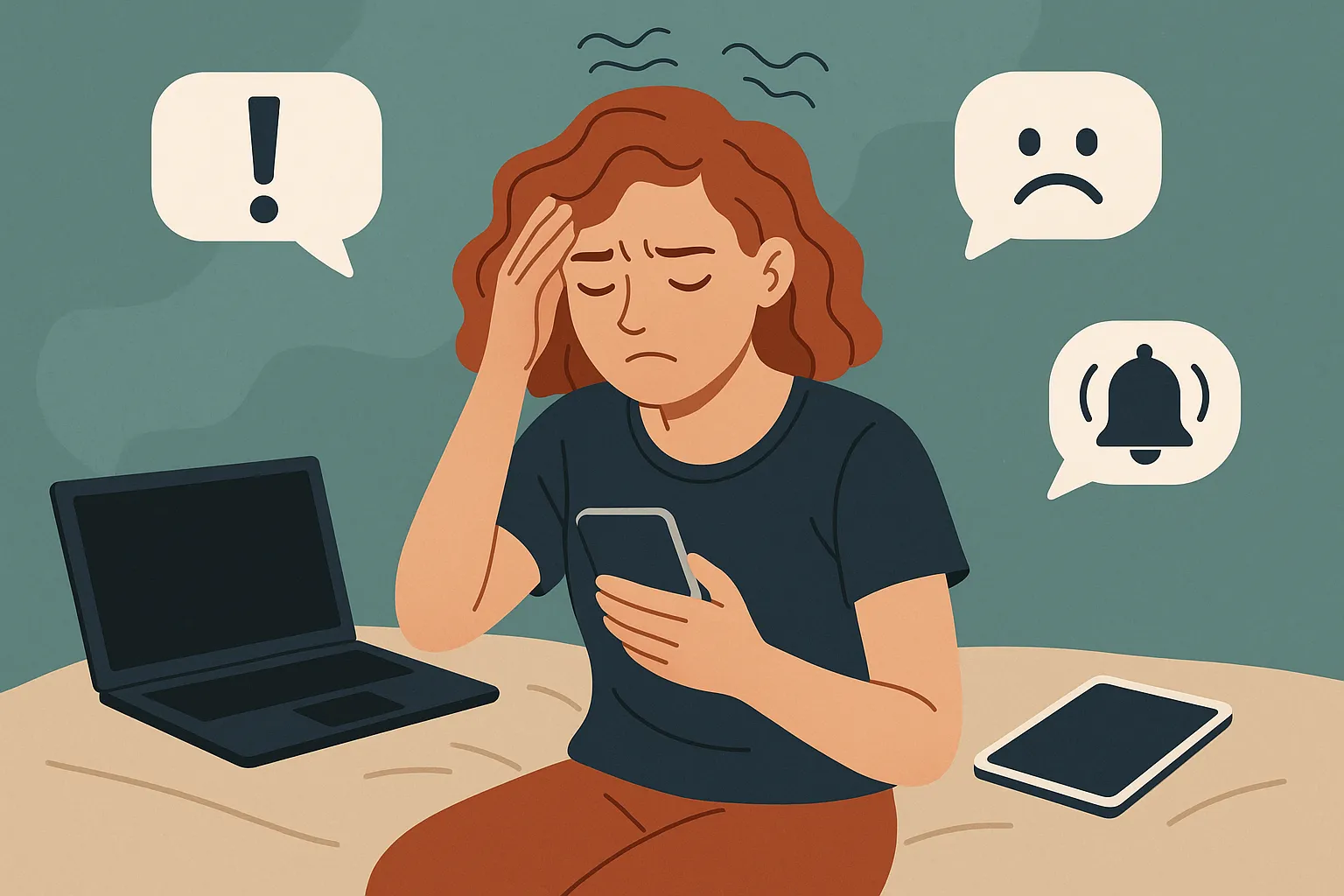Practical Guides to Go Further
These practical guides will help you apply the concepts discussed.

Complete Guide Digital Detox
Digital Detox Guide: Reclaim Your Focus and Wellbeing Feeling overwhelmed by constant notifications and endless scrolling? This guide offers simple, science-backed strategies to help you disconnect from digital overload, regain mental clarity, and build healthier tech habits—without quitting technology altogether.
The Hidden Sleep Thief: How Screen Time Is Sabotaging Your Rest and Mental Health
In today’s digital age, screen time isn’t just a part of daily life; for many of us, it is daily life. Whether we’re tackling work, unwinding with entertainment, or connecting with loved ones, screens are undeniably omnipresent. But here’s the thing though: this incredible convenience comes with a significant, often overlooked, drawback—its profound impact on our sleep. Understanding how screen time affects sleep isn’t just academic; it’s absolutely crucial for maintaining optimal mental health and our overall well-being. In this article, we’re going to dive deep into the fascinating, yet sometimes frustrating, relationship between our digital habits and our sleep, explore some vivid real-world scenarios, and offer practical, actionable best practices to genuinely mitigate those negative impacts.
The statistics paint a sobering picture: the average American now spends over 7 hours daily looking at screens, with many of us checking our phones within minutes of waking up and just before falling asleep. This digital bookending of our days creates what sleep researchers call “chronodisruption”—a systematic interference with our body’s natural timing mechanisms that has far-reaching consequences beyond simple fatigue.
The Science Behind Screen Time and Sleep: Unpacking the Digital Dilemma
The primary, and frankly, most concerning issue with excessive screen time is its direct interference with our body’s natural sleep cycle, scientifically known as the circadian rhythm. What’s interesting is how insidious this interference can be. The blue light emitted by our screens, from smartphones to tablets and laptops, actively suppresses the production of melatonin, the very hormone that acts as our body’s natural “sleep signal.” This suppression can lead to a cascade of problems: difficulties in falling asleep, struggling to stay asleep, and ultimately, failing to achieve that truly restorative, deep sleep we all crave.
Recent neurological research has revealed that this isn’t merely about light exposure—it’s about how our brains process digital stimulation. When we engage with screens, particularly interactive content, our brains release dopamine and cortisol, creating a state of heightened alertness that can persist for hours after we’ve powered down our devices. This neurochemical cocktail essentially puts our nervous system in a state that’s fundamentally incompatible with the relaxation necessary for quality sleep.
The Role of Blue Light: More Than Just a Glow
Blue light is a short-wavelength light that, surprisingly, is incredibly beneficial during daylight hours. It helps boost our attention, sharpens our reaction times, and even elevates our mood. Think of it as nature’s alarm clock. However, at night, it becomes problematic—a real biological spoiler. Our modern lives often involve staring at screens well past sunset, which essentially tricks our brain into believing it’s still broad daylight. This constant, artificial daytime signal significantly delays sleep onset. In fact, research consistently shows that prolonged blue light exposure delays sleep onset, shortens sleep duration, and impairs sleep efficiency by suppressing melatonin secretion.
What makes blue light particularly insidious is its wavelength—approximately 480 nanometers—which directly targets the intrinsically photosensitive retinal ganglion cells in our eyes. These specialized cells are essentially our body’s light sensors, and they’re exquisitely sensitive to blue light. When activated, they send signals directly to the suprachiasmatic nucleus, our brain’s master clock, effectively telling it to stay awake and alert. This biological mechanism evolved over millions of years to help us stay active during daylight hours, but our modern digital environment has hijacked this ancient system.
Impact on Circadian Rhythm: When Your Body Clock Goes Haywire
Our circadian rhythm is this incredible, natural internal process that meticulously regulates our sleep-wake cycle, repeating roughly every 24 hours. When this delicate cycle is disrupted, the consequences can be far-reaching, extending beyond just feeling groggy. We’re talking about potential sleep disorders and profound effects on mental health, including increased stress, anxiety, and even depression. A 2024 survey highlighted that high levels of stress correlate significantly with nighttime screen use, with users who rely on screens before bed reporting nearly 30% more stress. Consistent exposure to screens, especially in the hours leading up to bedtime, can shift this vital rhythm, resulting in diminished sleep quality and duration.
What’s even more concerning is that recent research from 2024 suggests that while blue light is a factor, the timing of screen use and the stimulating content itself might be even bigger culprits, particularly when devices are used in bed. It’s not just the light; it’s the engagement. The interactive nature of modern digital content—from social media notifications to streaming platforms designed to keep us watching—creates what researchers call “cognitive arousal,” a state of mental stimulation that can take hours to subside.
This disruption doesn’t just affect when we fall asleep; it fundamentally alters our sleep architecture. Studies using polysomnography (sleep monitoring equipment) have shown that people who use screens before bed experience reduced REM sleep, the crucial stage associated with memory consolidation, emotional processing, and mental health maintenance. They also spend less time in deep sleep stages, which are essential for physical recovery and immune system function.
Concrete Scenarios: Real-World Sleep Sabotage
Let’s look at some relatable examples of how this plays out in everyday life. You might even recognize yourself or someone you know in these situations. These scenarios illustrate the complex ways that screen time infiltrates our sleep patterns, often in ways we don’t immediately recognize.
Example 1: The Late-Night Social Scroller
Imagine Sarah, a high school student, who finds herself glued to her smartphone late into the night, scrolling through social media feeds and getting lost in mobile games. She knows she’s tired, but the endless stream of content is just too tempting. Despite feeling utterly exhausted, she struggles to fall asleep after finally putting her phone down. This isn’t just a minor delay; it’s a significant chunk of lost sleep that directly impacts her ability to concentrate and perform academically the next day. It’s a frustrating cycle that many young people, especially Gen Z, face, with 92.1% of Gen Z reportedly using screens before bed at least most of the time.
What makes Sarah’s situation particularly problematic is the addictive design of social media platforms. These apps employ what behavioral psychologists call “variable ratio reinforcement schedules”—the same psychological principle used in gambling. Each scroll might reveal something interesting, creating a dopamine hit that keeps her engaged far longer than she intended. The blue light exposure is compounded by the emotional and cognitive stimulation of social comparison, FOMO (fear of missing out), and the constant stream of new information her brain feels compelled to process.
Example 2: The Always-On Remote Professional
Consider Mark, a remote worker whose workday often stretches well into the evening, leaving him staring at his computer screen for long hours. The blue light from his monitor, combined with the cognitive stimulation of work, means that even after he logs off, his brain is still buzzing. This constant exposure makes it incredibly difficult for him to wind down and fall asleep, leading to persistent fatigue and a noticeable dip in productivity the following day. It’s a common challenge in our always-connected professional world.
Mark’s situation represents what sleep specialists call “work-related rumination”—the inability to mentally disconnect from work tasks. When combined with extended screen exposure, this creates a perfect storm for sleep disruption. His cortisol levels remain elevated well into the evening, his mind continues processing work-related problems, and the blue light exposure delays his natural melatonin production. This creates a vicious cycle where poor sleep leads to decreased productivity, which leads to longer work hours and later screen exposure, perpetuating the problem.
Example 3: The Binge-Watching Night Owl
Then there’s Emily, an individual who habitually watches television or streams content on her tablet right before bed. While it feels like unwinding, the engaging narratives and bright visuals keep her mind active. She finds it incredibly hard to wake up at a consistent time each morning, often hitting snooze multiple times. This irregular sleep pattern can lead to a form of “social jetlag,” where her internal biological clock is constantly out of sync with her daily responsibilities and societal norms, leaving her feeling perpetually off-kilter.
Emily’s binge-watching habit illustrates how streaming platforms have engineered their content to be maximally engaging. Features like autoplay, cliffhanger endings, and personalized recommendations are designed to keep viewers watching “just one more episode.” The combination of narrative engagement, bright screen exposure, and the irregular timing of her sleep creates what researchers call “social jetlag”—a misalignment between her biological clock and social obligations that can have serious health consequences over time.
Example 4: The Multitasking Parent
Let’s also consider David, a working parent who uses the late evening hours as his only opportunity for personal time. After putting the kids to bed, he simultaneously checks work emails on his laptop, scrolls through news on his tablet, and has the television on in the background. This multi-screen environment creates an overwhelming sensory experience that leaves his nervous system in a state of hyperarousal. Even when he finally gets to bed, his mind races with fragments of information from multiple sources, making quality sleep nearly impossible.
David’s scenario highlights how modern life often forces us into patterns of “continuous partial attention,” where we’re constantly processing multiple streams of information. This cognitive overload, combined with the cumulative blue light exposure from multiple devices, creates a particularly potent sleep disruptor that many busy adults experience but don’t fully understand.
Key Insights & Best Practices: Reclaiming Your Rest
So, what have we learned, and more importantly, what can we do? The relationship between screen time and sleep is complex, involving multiple biological, psychological, and behavioral factors that interact in ways we’re only beginning to understand.
Key Insights
-
Blue Light and Melatonin: The Biological Battle: The science is clear: blue light from screens actively suppresses melatonin production, directly delaying sleep onset and negatively affecting overall sleep quality. However, this suppression can occur even with relatively brief exposure—as little as 30 minutes of screen time can delay melatonin production for up to three hours.
-
Beyond Blue Light: Timing and Stimulation Matter: While blue light is a significant factor, newer research emphasizes that using screens in bed, especially for stimulating activities like gaming or social media, can be even more detrimental to sleep duration, regardless of the light color. The psychological association between the bed and wakefulness can create long-term sleep difficulties.
-
Mental Health Link: Disrupted sleep patterns aren’t just about feeling tired; they can significantly exacerbate existing mental health issues like anxiety and depression, and even contribute to increased stress. Poor sleep quality is both a symptom and a cause of mental health challenges, creating cycles that can be difficult to break without addressing screen habits.
-
Circadian Rhythm Disruption: Consistent screen time, particularly at night, can fundamentally shift your body’s natural circadian rhythm, potentially leading to chronic sleep disorders. This shift can affect not just sleep, but also hormone production, immune function, and metabolic processes.
-
Individual Sensitivity Varies: Recent research has shown that people have different levels of sensitivity to blue light and screen stimulation. Factors like age, genetics, existing sleep disorders, and even seasonal patterns can influence how dramatically screens affect individual sleep patterns.
-
Content Matters as Much as Light: The type of content consumed on screens plays a crucial role in sleep disruption. Emotionally charged content, whether it’s stressful news, exciting entertainment, or engaging social media, can create lasting arousal that persists long after the screen is turned off.
Best Practices: Simple Shifts for Better Sleep
Based on both established science and recent findings, here are my strong recommendations for cultivating healthier sleep habits in our digital world:
-
Institute a “Digital Sunset”: Aim to reduce or, ideally, eliminate screen time at least one hour before bedtime. Studies suggest that even one hour of screen use in bed can increase your risk of insomnia by a surprising 59% and cut your sleep time by 24 minutes. Give your body that crucial window to naturally increase melatonin levels. For optimal results, consider extending this window to 90 minutes, which allows for a complete sleep cycle preparation period.
-
Leverage Night Mode Features (But Don’t Rely Solely On Them): Most modern devices offer “night mode” or “blue light filter” settings that shift screen colors to warmer tones. While these are helpful in minimizing blue light emission, remember they don’t eliminate the stimulating effect of engaging content. It’s a good step, but not a magic bullet. Some devices now offer more sophisticated features like “bedtime mode” that not only filters blue light but also reduces notifications and limits access to stimulating apps.
-
Craft a Calming Bedtime Routine: Create a pre-sleep ritual that is entirely screen-free. This could be reading a physical book (remember those?), taking a warm bath, listening to calming music, or practicing meditation. Consistency is key here. Research shows that it takes approximately 21 days to establish a new habit, so be patient with yourself as you develop these new routines.
-
Optimize Your Sleep Environment: Ensure your bedroom is a true sanctuary for sleep. Keep it dark (block out all light sources, including device LEDs), quiet, and cool. A comfortable mattress and pillows also make a world of difference. Consider investing in blackout curtains, white noise machines, or even smart home technology that can automatically adjust lighting and temperature to support your sleep cycle.
-
Keep Screens Out of the Bedroom (Especially for Kids): This is perhaps one of the most impactful changes you can make. Having a television or internet-connected device in the bedroom is associated with shorter sleep duration. For children and adolescents, the American Academy of Pediatrics recommends keeping electronics out of bedrooms entirely. Create charging stations in common areas where devices can “sleep” overnight too.
-
Practice Strategic Screen Timing: If you must use screens in the evening, prioritize passive, calming content over interactive or stimulating material. Choose documentaries over action movies, instrumental music over high-energy playlists, and avoid social media or work-related content entirely in the hours before bed.
-
Use Light Therapy Strategically: Just as evening light exposure can disrupt sleep, morning light exposure can help regulate your circadian rhythm. Consider using a light therapy box in the morning, especially during darker months, to help maintain a healthy sleep-wake cycle.
-
Monitor Your Sleep Patterns: Use sleep tracking apps or devices to understand how your screen habits correlate with your sleep quality. Many people are surprised to discover the direct relationship between their evening screen time and their sleep metrics. However, be mindful not to become obsessive about sleep data, as this can create its own form of sleep anxiety.
FAQ: Your Burning Questions Answered
1. How much screen time is too much before bed?
Experts generally recommend avoiding screens for at least one hour before bedtime to prevent interference with melatonin production and maintain a healthy sleep cycle. However, recent research indicates that using screens in bed is particularly problematic, regardless of how long you’ve been off screens before that. The ideal approach is to establish a gradual wind-down period, reducing screen brightness and switching to less stimulating content 2-3 hours before bed, then eliminating screens entirely in the final hour.
2. Can blue light glasses help reduce sleep disruption?
Blue light blocking glasses can be effective in reducing blue light exposure, potentially improving sleep quality. However, as an expert, I’d emphasize that they are a supplementary tool, not a replacement for limiting overall screen time and engaging content before bed. The most effective blue light glasses block 90% or more of blue light in the 480nm range, but they don’t address the cognitive stimulation aspect of screen use. Some people find them helpful for evening computer work, but they shouldn’t be seen as a license to use screens freely before bed.
3. Is it harmful to use screens with “night mode” active?
While “night mode” or “dark mode” reduces blue light emission, it doesn’t eliminate it entirely, nor does it remove the cognitive stimulation that comes from engaging with content. It’s still advisable to limit screen time before bed, even with these features enabled. Night mode is most effective when combined with other sleep hygiene practices, and it’s particularly useful for people who must use screens in the evening for work or other essential activities.
4. Are children more affected by screen time than adults?
Yes, absolutely. Children and adolescents are generally more sensitive to the effects of blue light and screen stimulation, which can lead to greater disruptions in their sleep patterns and overall development. For instance, children aged 11-14 spend about 9 hours a day on screens, significantly impacting their sleep. Children’s eyes transmit more blue light to the retina than adult eyes, and their circadian rhythms are still developing, making them particularly vulnerable to screen-related sleep disruption. Additionally, children often have less self-regulation when it comes to screen use, making parental guidance crucial.
5. What are the long-term effects of disrupted sleep patterns due to screen time?
Chronic sleep disruption can lead to a host of serious long-term health issues, including obesity, cardiovascular disease, impaired cognitive function, and an increased risk of mental health disorders such as depression and anxiety. It’s a foundational element of our overall health. Recent longitudinal studies have also linked chronic sleep disruption to accelerated aging, increased inflammation, compromised immune function, and even increased risk of neurodegenerative diseases like Alzheimer’s. The cumulative effect of poor sleep over years or decades can significantly impact both lifespan and healthspan.
6. Do different types of screens affect sleep differently?
Yes, screen size, brightness, and viewing distance all play roles in sleep disruption. Larger screens like televisions, when viewed from a distance, may have less impact than smartphones held close to the face. However, the content and engagement level often matter more than the screen type. Tablets and smartphones used in bed are particularly problematic because they’re typically held close to the eyes and used for highly engaging activities.
7. Can screen time affect dreams and sleep quality beyond just falling asleep?
Absolutely. Screen time, particularly exposure to stimulating or emotionally charged content, can affect dream content, sleep architecture, and overall sleep quality. People who use screens before bed often report more vivid, sometimes disturbing dreams, and they spend less time in restorative deep sleep stages. The brain continues processing the information consumed on screens during sleep, which can lead to less restful sleep even when total sleep time appears adequate.
Advanced Strategies for Digital Wellness and Sleep Optimization
For those ready to take their sleep hygiene to the next level, consider these advanced strategies that go beyond basic screen time management:
Creating a Circadian-Friendly Home Environment
Transform your living space to support your natural sleep-wake cycle. Install smart lighting systems that automatically adjust color temperature throughout the day—bright, blue-rich light in the morning and warm, dim light in the evening. Use programmable thermostats to gradually cool your bedroom as bedtime approaches, mimicking the natural temperature drop that signals sleep time to your body.
The Power of Sleep Scheduling
Consistency is perhaps the most powerful tool in your sleep optimization arsenal. Going to bed and waking up at the same time every day, even on weekends, helps stabilize your circadian rhythm. This consistency makes it easier to resist the temptation of late-night screen use because your body naturally begins to feel sleepy at the appropriate time.
Mindful Technology Use
Practice intentional technology consumption by regularly auditing your digital habits. Ask yourself: What purpose does this screen time serve? Am I using technology, or is it using me? Consider implementing “digital sabbaths” or regular periods of complete disconnection to reset your relationship with technology and improve your overall sleep quality.
Conclusion: Taking Control of Your Digital Habits for Better Sleep
The impact of screen time on our sleep patterns is a significant, and growing, concern in the context of our collective mental and physical health. By truly understanding the intricate effects of blue light, the crucial importance of our circadian rhythm, and the often-underestimated power of stimulating content, we can make incredibly informed choices to minimize screen-related sleep disruptions.
The path forward isn’t about completely abandoning technology—that’s neither realistic nor necessary in our modern world. Instead, it’s about developing a more conscious, intentional relationship with our devices that prioritizes our biological needs and long-term health. This means recognizing that our ancient sleep systems are struggling to adapt to our modern digital environment, and we need to actively create boundaries and practices that support our natural rhythms.
Implementing best practices, such as establishing a “digital sunset,” leveraging (but not over-relying on) night mode features, and critically, creating a truly conducive sleep environment, can profoundly promote better sleep quality and overall well-being. Remember that small, consistent changes often yield more sustainable results than dramatic overhauls. Start with one or two strategies that feel manageable, and gradually build upon your success.
The investment you make in improving your sleep hygiene will pay dividends in every area of your life—from improved cognitive function and emotional regulation to better physical health and enhanced relationships. Quality sleep isn’t a luxury; it’s a fundamental requirement for human thriving.
For even more in-depth information on the effects of screen time and comprehensive sleep health, I highly recommend visiting authoritative resources like the National Sleep Foundation, which offers evidence-based guidance and the latest research on sleep optimization.
By taking these proactive steps to thoughtfully manage our screen time, we can ensure that technology genuinely enhances, rather than hinders, our quality of life and, crucially, our precious sleep. The future of our digital wellness depends not on the technology itself, but on how wisely we choose to integrate it into our lives while honoring our fundamental human need for restorative rest.







